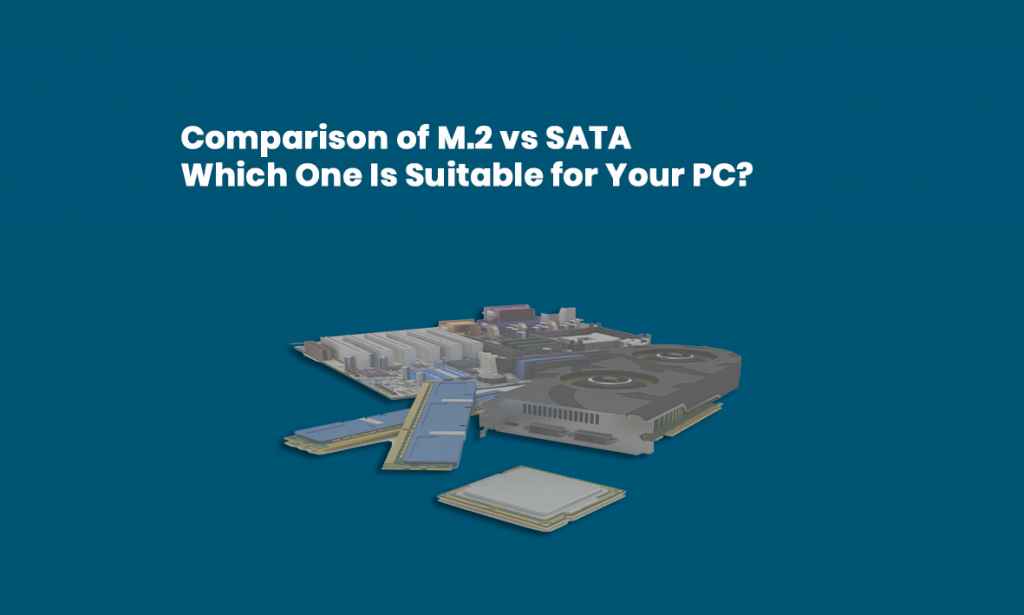Comparison of M.2 vs SATA – Which One Is Suitable for Your PC?
Do you know the difference between M.2 vs SATA?
M.2 is the best option for multiple storages. They are a type of Solid State drivers and quite similar to bubble gum stick. While SATA is used only for data storage devices.
Which one is the better option? Grid Hosting will give you an in-depth guide on it.
On several servers and computer motherboards, you can see the M.2 attachments. It is usually known as the Next-Generation form factor, the M.2 particular is viewed as a replacement to the mSATA standard, even though SSDs of the last kind are as yet being sold.
Regarding both extra room and actual measurements, M.2 SSD arrives in an assortment of sizes. Of course, information limits are signified by a few gigabytes (GB) or terabytes (TB), while the actual space taken up by the part is signified by a four or five-digit number.

In April 2018, South Korean gadgets goliath Samsung dispatched its 970 EVO M.2 SSDs with capacity limits of up to 2TB. This M2 SSD turns out to be a 2280 section, which means it estimates 22mm by 80mm. Albeit 22mm-wide M.2 modules are the standard, the M.2 standard back has different widths (12, 16 22, and 30 mm) and lengths (16, 26, 30, 38, 42, 60, 80, and 110 mm).
Detecting an M.2 space on a motherboard can be another practice for clients who are acclimated to fitting SSDs into a framework’s drive inlets or growing their PCs with PCIe cards and RAM modules.
Normally, M.2 spaces are masterminded so the SSD lies at the level of or corresponding to the motherboard. Some motherboards uphold the opposite direction, empowering the utilization of an M.2 SSD with a connector. Once fit properly, the framework will think about it one more drive, which can be arranged, doled out a drive letter, and other regular storage arrangement errands.
Aside from its density, M.2 is additionally an adaptable connector.
M.2 not only provisions SATA as well as PCIe, even though not simultaneously in a given M.2 SSD. It even assistances USB 3.0, Bluetooth, Wi-Fi, and Near-Field Communication (NFC) in specific designs.
Upon closer assessment of an M.2 module, clients may see that there are indents, or keys, where the connector pins are found, yielding topsy-turvy pin setups. These figures out which interface the M.2 module utilizes and the transport (PCIe, USB 3.0, and so forth) that it can associate with. It’s additionally a plan that forestalls opening an M.2 card into a contrary interface or setting it in an opposite setup.
M.2 SSDs are equipped for achieving high information move speeds, yet everything relies on the sort of capacity interface utilized.
A SATA-based M.2 SSD is restricted by SATA’s greatest constraint of 600 MB/s (megabytes every second). An M.2 SSD that upholds PCIe empowers it to utilize NVMe (Non-Volatile Memory Express), a low-idleness have regulator interface, particularly that arrives at rates of up to 4 GB/s (megabytes every second), conveying relatively rankling execution on viable motherboards.
What is SATA? M.2 vs SATA
SATA, the abbreviation used to depict the basic Serial Advanced Technology Attachment transport interface, is utilized to associate SSDs, hard plate drives (HDDs), and optical drives and is a capacity business basic.
It has generally ousted PATA, or Parallel ATA, stockpiling innovation mostly because it’s more slender, easier to use cabling and sprightlier execution qualities. As referenced before, SATA can arrive at rates of up to 600 MB/s while PATA finishes out at 133 MB/s.
SATA was not generally equipped for arriving at those speeds, even though it conveniently beat PATA out of the door. At the point when it was presented in 2000, SATA I or 1.0, had the option to move information at a pace of up to 150 MB/s. From that point forward, there have been a few execution upgrading modifications. Today, SATA 3 SSDs are creeping nearer to that previously mentioned maximum velocity of 600 MB/s.
There’s likewise amendment 3.2 from 2013. Assistant both SATA and PCIe in the SATA Express determination, it was made with rates of up to 1,969 MB/s as a primary concern. Not to be wrong for External Serial Advanced Technology Attachment (eSATA), SATA Express has not gotten on with SSD producers.
Different features incorporate hotplug uphold, permitting clients to append or eliminate a SATA stockpiling gadget from a framework. AHCI considers hotplug uphold and a drive advancement innovation that improves execution called local command queuing (NCQ).
The SATA standard is kept up by the Serial ATA International Organization (SATA-IO, or), a not-for-profit upheld by numerous IT titans. Benefactors incorporate AMD, Dell, HPE, Intel, Micron, Seagate, and numerous other IT sellers.
M.2 SSD vs. SATA SSD – M.2 vs SATA
SATA Bus Standard versus PCI-E Bus Standard
A Bus is a typical correspondence trunk that sends data between different user levels, (for example, CPU, memory, hard circle, and different info and yield gadgets) of a PC. It is a broadcast yoke made out of wires.
Bus standard specifies the segment side, pin area, and other specialized determinations. Along these lines, makers can create chips and gadgets (counting hard circles) as indicated by the bus principles and particulars.
SATA Bus standard is an outside memory transfer standard for hard disk. It embraces sequential association mode, which causes the interface to have preferences of the basic structure, quick exchange speed, high execution proficiency, more grounded mistake amending limit, and backing for the hotplug.
PCI-E Bus standard is an interior memory transfer standard, which is advanced to supplant PCI (Peripheral Component Interconnect) transport. It is a fast sequential highlight point double-channel high-transfer speed transmission.
Within the PCI-E bus standard, the associated gadgets are distributed among selective channel transfer speed and don’t impart assets to different gadgets. It mostly bolsters dynamic force executives, mistake announcing, start to finish dependable transmission, hot attachment, nature of administration, and different capacities. Most importantly, it has a high exchange rate.
From the point of read-compose speed, the PCI-E bus standard is before the SATA bus standard. In the SATA bus standard, the information activity measure is as per the following: information will be first perused from the hard disk to memory, and afterward separated to CPU for estimation, and then kept in touch with memory after figuring, lastly safe in the hard disk.
Final Words
In any case, in the PCI-E bus standard, the information is legitimately associated with the CPU via the bus, and the requirement for storage to call the hard disk is disposed of so the PCI-E move speed is near the greatest transmission speed. Here at Grid hosting, I have described the M.2 vs SATA for the people who don’t know what are these terms and how these terms work and are used.







